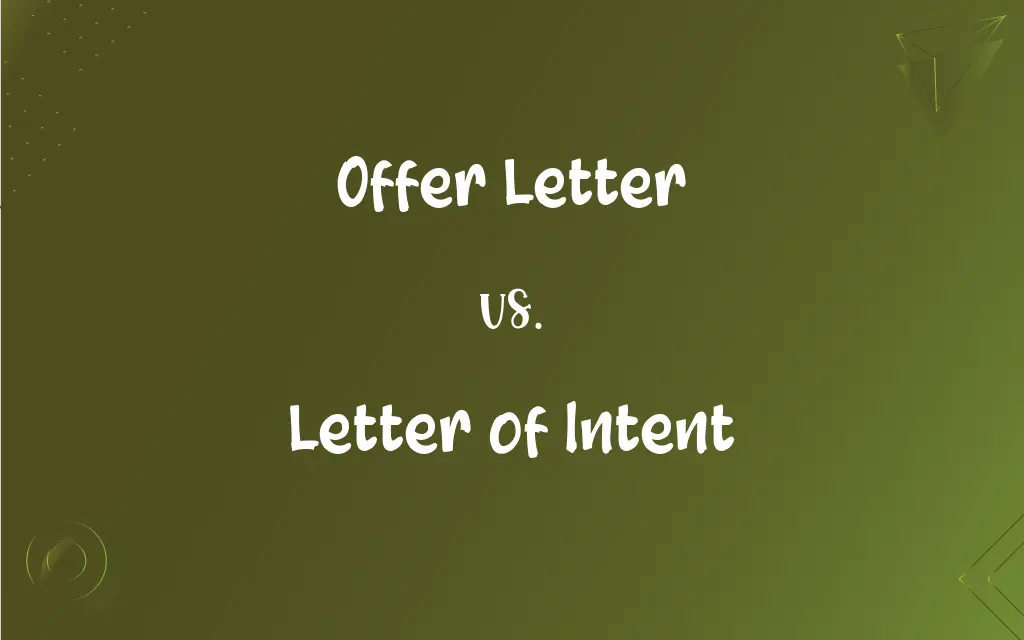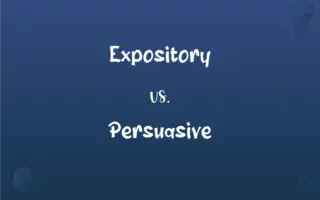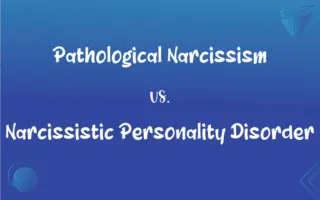Offer Letter vs. Letter of Intent: What's the Difference?
Edited by Aimie Carlson || By Janet White || Published on January 10, 2024
An offer letter is a formal job proposal from an employer, while a letter of intent expresses a non-binding interest in a business deal or employment.

Key Differences
An offer letter is a definitive employment agreement, providing specific details about the job role, salary, and terms of employment. In contrast, a letter of intent serves as a preliminary expression of interest, often used in business transactions or potential employment situations, but it is not a final agreement.
The offer letter represents a formal commitment by an employer to a potential employee, outlining the conditions of employment. The letter of intent, while important, is more a gesture of goodwill, indicating a desire to move forward with negotiations or discussions, but without the binding commitments found in an offer letter.
In terms of legal standing, an offer letter can be binding once accepted by the recipient, creating an official employer-employee relationship. A letter of intent, however, generally lacks the binding power of an offer letter, acting more as a roadmap for future negotiations or agreements.
Offer letters are often the culmination of a successful interview or negotiation process, signifying a clear intention to hire. Letters of intent can be used in various stages of business dealings, from preliminary discussions to the phase just before finalizing a formal contract.
Offer letters are typically more detailed, including specific job responsibilities, start dates, salary, and benefits. Letters of intent are usually less detailed, highlighting the potential areas of agreement or interest without delving into the specifics that would be found in a final contract or offer letter.
ADVERTISEMENT
Comparison Chart
Purpose
Formal job offer
Expression of interest
Binding Nature
Often legally binding once accepted
Generally non-binding
Content Specificity
Detailed with specific terms
Broad and less detailed
Usage Context
Employment
Business deals, potential employment
Stage of Process
Culmination of hiring process
Early or mid-negotiation stage
ADVERTISEMENT
Offer Letter and Letter of Intent Definitions
Offer Letter
A commitment from the employer to the employee.
The offer letter signified the company's commitment to hire him.
Letter of Intent
An initial expression of interest in a deal.
They sent a letter of intent to signal their interest in the partnership.
Offer Letter
The final step in the recruitment process.
After the interview, he was eagerly waiting for the offer letter.
Letter of Intent
Used to facilitate early discussions.
Their letter of intent set the stage for detailed negotiations.
Offer Letter
A binding agreement outlining job specifics.
The offer letter included his start date and salary.
Letter of Intent
Precedes formal business agreements.
The letter of intent was followed by detailed contract discussions.
Offer Letter
Includes detailed job role and compensation.
Her offer letter outlined the job responsibilities clearly.
Letter of Intent
Indicates a party's interest without commitment.
The company issued a letter of intent to explore the acquisition.
Offer Letter
An official document stating the terms of employment.
She received an offer letter from her dream company.
Letter of Intent
A non-binding outline of a potential agreement.
The letter of intent was a first step towards negotiating the contract.
FAQs
Can a letter of intent lead to a contract?
Yes, it often precedes and sets the stage for a formal contract.
Is an offer letter legally binding?
Yes, it becomes binding when accepted by the recipient.
Who issues an offer letter?
Typically, an employer or hiring manager.
Who uses a letter of intent?
Businesses, individuals in negotiations, or job applicants.
How formal is an offer letter?
It's a formal and official employment document.
What is an offer letter?
It's a formal job proposal detailing the terms of employment.
Can an offer letter be negotiated?
Yes, candidates can negotiate terms before accepting.
What is a letter of intent?
It's a document expressing non-binding interest in a deal or employment.
What details are included in an offer letter?
Job role, salary, benefits, and other employment terms.
Can a letter of intent be withdrawn?
Yes, since it's non-binding, it can be withdrawn.
Is a letter of intent detailed?
It's less detailed and more general than an offer letter.
Does a letter of intent imply commitment?
No, it's an expression of interest without firm commitment.
Is an offer letter used in business deals?
It's primarily used for employment offers, not general business deals.
Can a letter of intent be informal?
It's usually formal but less binding than an offer letter.
Does an offer letter require a response?
Yes, it typically requires acceptance or rejection.
Is an offer letter a contract?
It's akin to a contract, laying out terms of employment.
What’s the purpose of a letter of intent?
To express preliminary interest in a deal or potential employment.
What signifies acceptance of an offer letter?
Signing and returning the letter indicates acceptance.
What happens after a letter of intent?
It leads to further negotiations or discussions.
Does a letter of intent guarantee a deal?
No, it doesn't guarantee a deal will be finalized.
About Author
Written by
Janet WhiteJanet White has been an esteemed writer and blogger for Difference Wiki. Holding a Master's degree in Science and Medical Journalism from the prestigious Boston University, she has consistently demonstrated her expertise and passion for her field. When she's not immersed in her work, Janet relishes her time exercising, delving into a good book, and cherishing moments with friends and family.
Edited by
Aimie CarlsonAimie Carlson, holding a master's degree in English literature, is a fervent English language enthusiast. She lends her writing talents to Difference Wiki, a prominent website that specializes in comparisons, offering readers insightful analyses that both captivate and inform.







































































